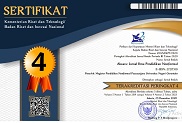Manajemen Kepemimpinan Kepala Sekolah Perempuan: Analisis Model CIPP
Abstract
The dominance of men still remains in school management positions even though the phenomenon of the proportion of women achieving leadership roles continues to increase. The aim of this study is to describe women's leadership management by observing women's leadership behavior in schools. This type of qualitative research applies observation, interviews and documentation when providing data. The results showed (1) Planning to improve the quality of education based on the vision, mission, which is arranged accordingly directions from the Head of the West Kutai Regency Education Office; (2) Organizing institutions is carried out responsibly, creating a conducive school climate. (3) Monitoring system for teacher activities, student learning outcomes through academic supervision; (4) The SMPN 4 activity evaluation system involves parents by consensus.
Dominasi laki-laki masih bertahan pada posisi manajemen sekolah meskipun fenomena proporsi perempuan mencapai peran kepemimpinan terus meningkat..Tujuan penelitian ini adalah mendeskripsikan manajemen kepemimpinan perempuan dengan mengamati perilaku kepemimpinan perempuan di sekolah. Jenis penelitian kualitatif dengan menerapkan observasi , wawancara dan dokumentasi saat penyediaan data. Hasil penelitian menunjukkan (1) Perencanaan peningkatan mutu pendidikan berdasarkan visi, misi, yang disusun sesuai arahan Kepala Dinas Pendidikan Kabupaten Kutai barat; (2) Pengorganisasian lembaga dilaksanakan secara tanggung jawab , menciptakan iklim sekolah yang kondusif. (3) Sistem monitoring aktivitas guru , hasil belajar siswa melalui supervisi akademik ; (4) Sistem evaluasi aktivitas SMPN 4 melibatkan orang tua secara mufakat.
Keywords
Full Text:
PDFReferences
Acker, S. (1995). Carry on Caring: The Work of Women Teachers. British Journal of Sociology of Education, 16(1), 21-36.
Apriani, F. (2011). Pengaruh Kompetensi, Motivasi, dan Kepemimpinan terhadap Efektivitas Kerja. Bisnis & Birokrasi Journal, 16(1).
Carli, L. L., & Eagly, A. H. (1999). Gender Effects on Social Influence and Emergent Leadership.
Carli, L. L., & Eagly, A. H. (2001). Gender, hierarchy, and leadership: An introduction. Journal of Social Issues, 57(4), 629-636.
Coder, L., & Spiller, M. S. (2013). Leadership education and gender roles: Think manager, think"?". Academy of Educational Leadership Journal, 17(3), 21.
Djafri, N. (2017). Manajemen Kepemimpinan Kepala Sekolah:(Pengetahuan Manajemen, Efektivitas, Kemandirian Keunggulan Bersaing dan Kecerdasan Emosi). Deepublish.
Eagly, Alice H, & Carli, L. L. (2003). Finding Gender Advantage and Disadvantage: Systematic Research Integration is The Solution. The Leadership Quarterly, 14(6), 851-859.
Eagly, Alice H, & Carli, L. L. (2012). Women and The Labyrinth of Leadership. Contemporary Issues in Leadership, 147-162.
Eagly, Alice Hendrickson, Eagly, L. L. C. A. H., & Carli, L. L. (2007). Through The Labyrinth: The Truth About How Women Become Leaders. Harvard Business Press.
Fridell, M., Belcher, R. N., & Messner, P. E. (2009). Discriminate analysis gender public school principal servant leadership differences. Leadership & Organization Development Journal.
Gibson, J. L., Ivancevich, J. M., & Donnelly, J. H. (1996). Organisasi: Perilaku, Struktur dan Proses. In Bina Rupa Aksara. Jakarta.
Hoyt, C L, & Simon, S. (2016). Gender and leadership. Leadership Theory and Practice, 397-426.
Hoyt, Crystal L, & Burnette, J. L. (2013). Gender Bias in Leader Evaluations: Merging Implicit Theories and Role Congruity Perspectives. Personality and Social Psychology Bulletin, 39(10), 1306-1319.
Reay, D., & Ball, S. J. (2000). Essentials of female management: women's ways of working in the education market place? Educational Management & Administration, 28(2), 145-159.
Stufflebeam, D. L. (2007). CIPP evaluation model checklist. Retrieved January, 8(2012), 717-733.
Sutanto, E. M., & Stiawan, B. (2000). Peranan Gaya Kepemimpinan yang Efektif dalam Upaya Meningkatkan Semangat dan Kegairahan Kerja Karyawan di Toserba Sinar Mas Sidoarjo. Jurnal Manajemen dan Kewirausahaan, 2(2), 29-43.
Wibowo, I., Si, M., & Saputra, W. (2017). Pengaruh Gaya Kepemimpinan Terhadap Kinerja Pegawai Melalui Disiplin Dan Motivasi Kerja Pegawai PPSU Kelurahan Duren Sawit Jakarta Timur. Jurnal Manajemen Bisnis Krisnadwipayana, 5(2).
Winardi, J., Nurkolis, N., & Yuliejantiningsih, Y. (2017). Pengaruh Kepemimpinan Kepala Sekolah Dan Kompetensi Profesional Guru terhadap Sekolah Efektif pada SMP Negeri Rayon Patebon Kabupaten KendaL. Jurnal Manajemen Pendidikan (JMP), 6(2).
Wirawan, D. (2013). Kepemimpinan: Teori, Psikologi, Perilaku Organisasi, Aplikasi dan Penelitian. Jakarta PT. Rajagrafindo Persada.
DOI: http://dx.doi.org/10.37905/aksara.7.1.1-14.2021
Refbacks
- There are currently no refbacks.
Copyright (c) 2021 Aksara: Jurnal Ilmu Pendidikan Nonformal

This work is licensed under a Creative Commons Attribution-ShareAlike 4.0 International License.
Publisher:
Magister Pendidikan Nonformal Pascasarjana Universitas Negeri Gorontalo
Jl. Soedirman No. 06 Gorontalo 96128 e-mail: jurnalaksara@ung.ac.id
http://ejurnal.pps.ung.ac.id







